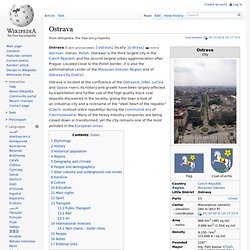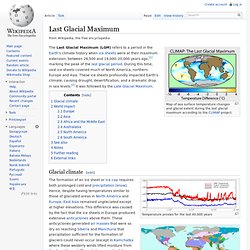

Mousterian Pluvial. The Mousterian Pluvial was an extended wet and rainy period in the climate history of North Africa.

It occurred during the Upper Paleolithic era, beginning around 50,000 years before the present (B.P), lasting 20,000 years, and ending around 30,000 B.P. During the Mousterian Pluvial, the now-desiccated regions of northern Africa were well-watered, bearing lakes, swamps, and river systems that no longer exist. Vallon-Pont-d'Arc. Vallon-Pont-d'Arc (occitan Valon) is a commune in the Ardèche department in southern France.

Vallon-Pont-d'Arc is a capital of prehistoric and cultural tourism. This small village, peaceful in wintertime, sees its population expand ten-fold in summer. Its touristic importance largely comes from the fact that it is the departure point for the descent of the gorge of the Ardèche river (from Pont d'Arc to Saint-Martin-d'Ardeche). Geography[edit] Chauvet Cave. Drawings of horses from Chauvet Cave. Venus of Petřkovice. Replica of Venus of Petřkovické The Venus of Petřkovice (Czech: Petřkovická venuše or Landecká venuše) is a pre-historic Venus figurine, a mineral statuette of a nude female figure, dated to about 23,000 BCE (Gravettian industry) in Czechoslovakia.

Discovery[edit] It was found within the current city limits of Ostrava (Ostrava-Petřkovice), Silesia, in the Czech Republic, by archaeologist Bohuslav Klima on 14 July 1953. It was beneath a mammoth molar at an ancient settlement of mammoth hunters. Many stone artifacts and skeletal fragments were also found nearby. Features[edit] The statue measures 4.5 x 1.5 x 1.4 cm and is a headless torso of a woman carved from iron ore (hematite). Ostrava. City logo Ostrava (Czech pronunciation: [ˈostrava], locally: [oˈstrava] ( ); German: Ostrau, Polish: Ostrawa) is the third largest city in the Czech Republic and the second largest urban agglomeration after Prague.

Located close to the Polish border, it is also the administrative center of the Moravian-Silesian Region and of Ostrava-City District. Brno. Brno (English pronunciation: /ˈbɜrnoʊ/;[7] Czech pronunciation: [ˈbr̩no] ( Brno is the seat of judicial authority of the Czech Republic – it is the seat of the Constitutional Court, the Supreme Court, the Supreme Administrative Court, and the Supreme Public Prosecutor's Office.

The city is also a significant administrative centre. It is the seat of a number of state authorities, including the Ombudsman,[9] the Office for the Protection of Competition[10] and the Czech Agriculture and Food Inspection Authority.[11] Brno is also an important centre of higher education, with 33 faculties belonging to 13 institutes of higher learning and about 89,000 students.[12] There is also a studio of Czech Television[13] and Czech Radio.[14] Venus of Brassempouy. The Venus of Brassempouy (French: la Dame de Brassempouy, meaning "Lady of Brassempouy", or Dame à la Capuche, "Lady with the Hood") is a fragmentary ivory figurine from the Upper Palaeolithic.

It was discovered in a cave at Brassempouy, France in 1892. About 25,000 years old, it is one of the earliest known realistic representations of a human face. Discovery[edit] Brassempouy. The settlement is on the route between Mont-de-Marsan and Orthez.

Population[edit] Prehistoric caves[edit] The village became famous for its two nearby caves, and only 100 metres from each other, were among the first Paleolithic sites to be explored in France. They are known as the Galerie des Hyènes (Gallery of the Hyenas) and the Grotte du Pape (the "Pope's Cave"), in which the Venus of Brassempouy was discovered in 1892, accompanied by eight other human figures, often ignored, and an example of unfinished work, with multiple figures of women being carved at the same time. Landes (department) Landes (French pronunciation: [lɑ̃d]; Gascon : Lanas or Lanes) is a department in southwestern France.

Landes is one of the original 83 departments that were created during the French Revolution on 4 March 1790. It was created from parts of the provinces of Guyenne and Gascony. The Nobel Prize winning novelist François Mauriac set his novels in the Landes. Landes is part of the current région of Aquitaine and is surrounded by the départements of Gironde, Lot-et-Garonne, Gers, and Pyrénées-Atlantiques, as well as the Atlantic Ocean on the west. With an area stretching over more than 9000 km², Landes is, after Gironde, the second largest department of the metropolitan French territory.
Saint-Germain-en-Laye. Inhabitants are called Saint-Germanois.

Last Glacial Maximum. Map of sea surface temperature changes and glacial extent during the last glacial maximum according to the CLIMAP project.

The Last Glacial Maximum (LGM) refers to a period in the Earth's climate history when ice sheets were at their maximum extension, between 26,500 and 19,000–20,000 years ago,[1] marking the peak of the last glacial period. During this time, vast ice sheets covered much of North America, northern Europe and Asia. These ice sheets profoundly impacted Earth's climate, causing drought, desertification, and a dramatic drop in sea levels.[2] It was followed by the Late Glacial Maximum. Venus of Willendorf. The Venus of Willendorf, now known in academia as the Woman of Willendorf, is a 4.25-inch (10.8 cm) high statuette of a female figure estimated to have been made between about 28,000 and 25,000 BCE.[1] It was found in 1908 by a workman named Johann Veran[2] or Josef Veram[3] during excavations conducted by archaeologists Josef Szombathy, Hugo Obermaier and Josef Bayer at a paleolithic site near Willendorf, a village in Lower Austria near the city of Krems.[4] It is carved from an oolitic limestone that is not local to the area, and tinted with red ochre.
The figurine is now in the Naturhistorisches Museum in Vienna, Austria.[5] Venus of Willendorf is named after the site in Austria where it was unearthed.[6] Dating[edit] Venus of Willendorf. Naturhistorisches Museum. The Naturhistorisches Museum (German: Museum of Natural History), also known as the NHMW, is a large natural history museum located in Vienna, Austria.[1][2] The museum's website provides an overview in the form of a virtual tour.[2] The museum's earliest collections of artifacts were begun over 250 years ago.[1] Today, its collections on display cover 8,700 square metres (94,000 sq ft). As of 2011, the museum houses approximately 30 million objects and the number is growing.
Vienna. Geography and climate[edit] Winter in Vienna under snow Vienna is located in northeastern Austria, at the easternmost extension of the Alps in the Vienna Basin.